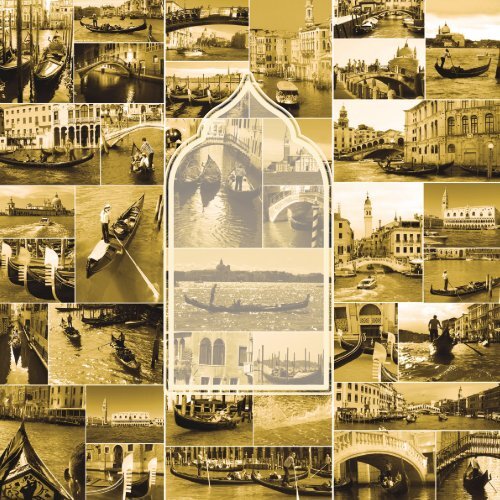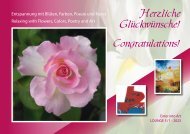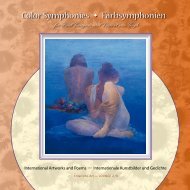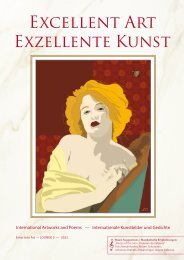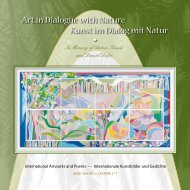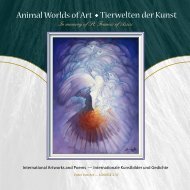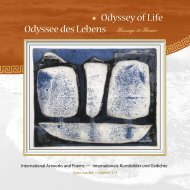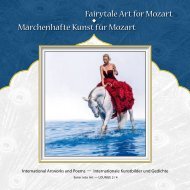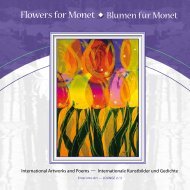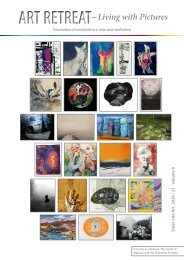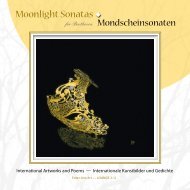Inspiration Venice - Inspiration Venedig
Relax and Rejoice with Art and Poetry from 29 Countries: Venice stirs admiration and wonder and exerts a strange power over the imagination. At times its appearance resembles a theater production, at times a mirage from 1001 Night. Strolling through it feels like sliding into a daydream – shimmering like mother-of-pearl, everything solid dissolves into water and colors. For centuries, the poetic melancholy of the lagoon city has been challenging artists and poets with its magic. Even its name stirs up associations with “Venus” who sprang from the foam of the sea. As Goethe’s “Venetian Epigrams”, this book also features artworks that lack any direct connection with Venice because inspiration may be expressed in the most diverse facets. In this spirit, 63 artists from 29 countries have come together at the occasion of the 700th anniversary of Venice-born traveler Marco Polo’s death, to celebrate the miracle of “La Serenissima” with contemporary imagery. The editor of this book has divided the artworks from around the world into chapters and added selected haiku poems, exquisite quotes, descriptive statements, and photo images. The result is a multifaceted homage from their imaginative perspective. Venedig weckt Bewunderung und Staunen und übt eine merkwürdige Macht auf die Imagination aus. Mal ähnelt das Auftreten der Stadt einer theatralischen Inszenierung, dann wieder einer Fata Morgana aus 1001 Nacht. Durch sie zu schlendern, bedeutet in eine Art Tagtraum hinüberzugleiten - perlmuttschimmernd löst sich alles Solide in Wasser und Farben auf. Seit Jahrhunderten fordert die poetisch-melancholische Lagunenstadt mit ihrem Zauber Künstler und Dichter heraus. Schon ihr Name erinnert an „Venus“, die Schaumentstiegene. Ähnlich Goethes „Venezianischen Epigrammen“ werden in diesem Buch aber auch Kunstwerke ohne direkten Bezug zu Venedig gezeigt, denn Inspiration kann sich in den verschiedensten Facetten äußern. In diesem Geiste haben sich zum 700. Todestag des in Venedig geborenen Marco Polo 63 Künstler aus 29 Ländern zusammengefunden, um dem Wunder von „La Serenissima“ mit zeitgenössischer Bildhaftigkeit zu begegnen. Der Herausgeber dieses Geschenkbuches hat die Kunstwerke aus aller Welt in Kapitel gruppiert und ihnen Haiku-Poesie, erlesene Zitate, kunstästhetische Aussagen und Illustrationen zur Seite gestellt. Das Ergebnis ist eine vielseitige Hommage aus ihrer fantasievollen Sicht.
Relax and Rejoice with Art and Poetry from 29 Countries: Venice stirs admiration and wonder and exerts a strange power over the imagination. At times its appearance resembles a theater production, at times a mirage from 1001 Night. Strolling through it feels like sliding into a daydream – shimmering like mother-of-pearl, everything solid dissolves into water and colors. For centuries, the poetic melancholy of the lagoon city has been challenging artists and poets with its magic. Even its name stirs up associations with “Venus” who sprang from the foam of the sea. As Goethe’s “Venetian Epigrams”, this book also features artworks that lack any direct connection with Venice because inspiration may be expressed in the most diverse facets. In this spirit, 63 artists from 29 countries have come together at the occasion of the 700th anniversary of Venice-born traveler Marco Polo’s death, to celebrate the miracle of “La Serenissima” with contemporary imagery. The editor of this book has divided the artworks from around the world into chapters and added selected haiku poems, exquisite quotes, descriptive statements, and photo images. The result is a multifaceted homage from their imaginative perspective.
Venedig weckt Bewunderung und Staunen und übt eine merkwürdige Macht auf die Imagination aus. Mal ähnelt das Auftreten der Stadt einer theatralischen Inszenierung, dann wieder einer Fata Morgana aus 1001 Nacht. Durch sie zu schlendern, bedeutet in eine Art Tagtraum hinüberzugleiten - perlmuttschimmernd löst sich alles Solide in Wasser und Farben auf. Seit Jahrhunderten fordert die poetisch-melancholische Lagunenstadt mit ihrem Zauber Künstler und Dichter heraus. Schon ihr Name erinnert an „Venus“, die Schaumentstiegene. Ähnlich Goethes „Venezianischen Epigrammen“ werden in diesem Buch aber auch Kunstwerke ohne direkten Bezug zu Venedig gezeigt, denn Inspiration kann sich in den verschiedensten Facetten äußern. In diesem Geiste haben sich zum 700. Todestag des in Venedig geborenen Marco Polo 63 Künstler aus 29 Ländern zusammengefunden, um dem Wunder von „La Serenissima“ mit zeitgenössischer Bildhaftigkeit zu begegnen. Der Herausgeber dieses Geschenkbuches hat die Kunstwerke aus aller Welt in Kapitel gruppiert und ihnen Haiku-Poesie, erlesene Zitate, kunstästhetische Aussagen und Illustrationen zur Seite gestellt. Das Ergebnis ist eine vielseitige Hommage aus ihrer fantasievollen Sicht.
You also want an ePaper? Increase the reach of your titles
YUMPU automatically turns print PDFs into web optimized ePapers that Google loves.
Taking a walk through <strong>Venice</strong> has something surreal about it<br />
In the 13th century, the number of trading houses<br />
in Constantinople was hardly lower than the one in<br />
<strong>Venice</strong> itself. Not only was “La Serenissima” an outpost<br />
of the Byzantine Empire for a long time, during<br />
the Sack of Constantinople in 1204, everything of<br />
value was also brought to <strong>Venice</strong> from one of the<br />
world’s wealthiest cities, including the large bronze<br />
horses above the entrance of St. Mark’s Basilica.<br />
<strong>Venice</strong> acquired major parts of Eastern Europe and<br />
the Near East. In the 15th century, the weakened<br />
Byzantium was an easy victim for the Ottomans<br />
who promptly granted the Venetians trade freedom<br />
in all parts of their empire. <strong>Venice</strong> saw itself as<br />
Byzantium’s heir. In the 16th century, it became the<br />
center of the world economy. In exchange for Asian<br />
goods, the Venetians exported mainly luxury items<br />
and glass.<br />
The tight connection with Byzantine and Oriental<br />
culture noticeably influenced the city’s architecture.<br />
The focus is on rounded cupolas and<br />
arches, shimmering mosaics, and variety rather<br />
than uniformity. The admiration of distant cultures<br />
has led to oriental borrowings even in the facade<br />
of the Doge’s Palace. St. Mark’s Basilica, too, was<br />
based on the model of Constantine’s Apostoleion.<br />
Weightlessly balanced, <strong>Venice</strong> brims with traces of<br />
“the other”. Whether it is owed to the city’s strict<br />
policy of neutrality, its former lagoon location,<br />
or simply the respect people have always had for<br />
its incomparable beauty – <strong>Venice</strong> has never been<br />
destroyed and ended up being the stage for a flourishing<br />
intercultural life. The sea opened its passage<br />
to wealth and riches. The tolerance that dominated<br />
the city’s culture was unknown elsewhere. The citystate<br />
became a model for the intellectuals of the<br />
Enlightenment, for England, and the New World.<br />
To Petrarch on the other hand, <strong>Venice</strong> was the<br />
“city of the sailors”, where he lost his fame. Johann<br />
Wolfgang von Goethe, too, saw something other<br />
than the beauty of “La Serenissima”. During his second<br />
trip to Italy, he worked on a collection of historical<br />
observations called “The Venetian Epigrams”.<br />
Bocaccio mentioned the city’s depravity in his<br />
„Decameron“. Not only the combination of orient<br />
and occident made <strong>Venice</strong> so stimulating, but also<br />
that of beauty and decadence. In his brilliant poem<br />
“The Courtesan”, Rilke compares the eyebrows of a<br />
seductive woman with the bridges of <strong>Venice</strong>. The<br />
famous adventure of the legendary Venetian Casanova<br />
tells about his escape from the lead chambers<br />
at the Bridge of the Sighs. Goethe referred to the<br />
gondolas as “spacious biers”, Byron used the term<br />
“coffin”. Although millions of visitors crowd the city<br />
during the day, at night, it appears strangely abandoned.<br />
In E.T.A. Hoffmann’s story “Doge and Dogaress”,<br />
readers can virtually grasp the city’s aura of<br />
the mysterious, scheming, cryptic, and threatening.<br />
Daphne du Maurier’s psycho-horror thriller “Don’t<br />
Look Now”, and the crime fiction classics by Patricia<br />
Highsmith and Donna Leon, also feature the labyrinthine<br />
beauty of the city by the water.<br />
The novelist Franz Werfel has Giuseppe Verdi<br />
travel to <strong>Venice</strong> for the carnival. When he wants to<br />
visit Richard Wagner, who is also staying there, he<br />
realizes that Wagner has died during the night. The<br />
dominating water intensifies the impression of fog<br />
and haze, in which only the beating of the oars, the<br />
sound of the bells, and the muted thuds of steps<br />
can be heard. <strong>Venice</strong> is ruled by the tide – and thus<br />
by the moon. Monet, Manet, and Turner found light<br />
there, and flowing movement. Albrecht Dürer studied<br />
the Venetian artists Titian, Giorgione, and Bellini.<br />
His portrait of a Venetian woman was painted<br />
in 1505. The city’s painters were known for their skill<br />
to depict hues of gold, and the texture of velvet and<br />
satin. The typical sheen of the city’s oriental interiors<br />
can also be found in their paintings. Tintoretto’s<br />
work was famous as a majestic theater. As Venetian<br />
visual art, the music of Monteverdi and Vivaldi also<br />
reflects the rhythm of the sea in the form of a melodious<br />
flooding. Mozart, Scarlatti, and Gluck were<br />
also inspired by <strong>Venice</strong>.<br />
Naturally, all great artists have been to <strong>Venice</strong>,<br />
only to confirm with a single voice that “La Serenissima”<br />
is a dream come true. The Caffé Florian’s<br />
record of visitors features Lord Byron, the brothers<br />
Gozzi, Henri Rousseau, Dumas père, Alfred de Musset<br />
and George Sand, Arthur Schopenhauer, and<br />
Henry James. Mark Twain, Charles Dickens, Auguste<br />
Renoir, Marcel Proust, Gerhart Hauptmann, Edgar<br />
Allan Poe, Friedrich Nietzsche, Felix Mendelssohn,<br />
and Igor Strawinsky – all of them felt like they were<br />
walking through a fantastic dream. Lord Byron<br />
and Alberto Moravia delved into Venetian culture<br />
by visiting the Carnival. Henry James stayed at the<br />
Palazzo Barbaro and used it as a setting in his novel<br />
“The Wings of the Dove”. Ernest Hemingway usually<br />
spent the night at Gritti Palace and made the city<br />
unforgettable in his novel “Across the River and<br />
Into the Trees”. In 1911, Thomas Mann stayed at the<br />
Grand Hotel de Bains on the Lido. He processed his<br />
Collage: Homage to <strong>Venice</strong><br />
11


